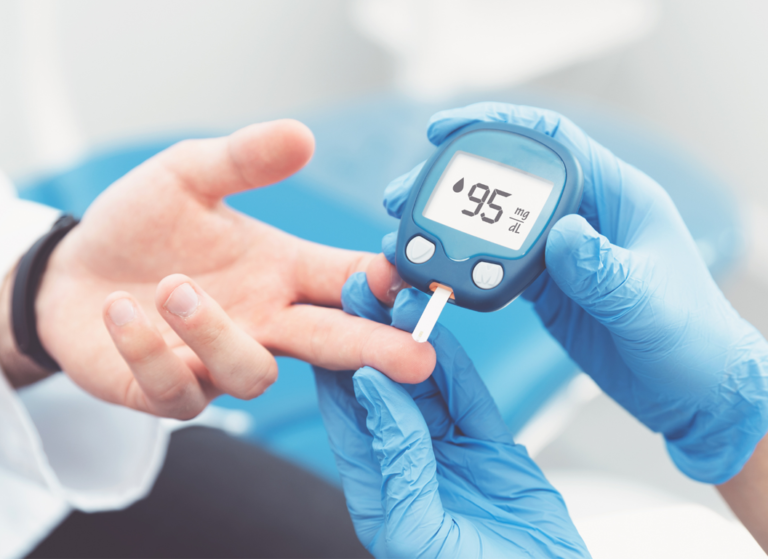DIABETES

Diabetes is a chronic condition where the body either doesn’t produce enough insulin or can’t effectively use the insulin it produces, leading to elevated blood sugar levels. If not well managed, diabetes can cause serious health complications. Here’s an overview of types, causes, symptoms, management, and potential complications:
1. Types of Diabetes
• Type 1 Diabetes: An autoimmune condition where the immune system attacks insulin-producing cells in the pancreas, resulting in little to no insulin production. It typically develops in childhood or adolescence, though it can appear in adults.
• Type 2 Diabetes: The most common type, where the body becomes resistant to insulin or doesn’t make enough insulin. This form is strongly linked to lifestyle factors and often develops in adults, though it is increasingly seen in younger people.
• Gestational Diabetes: Develops during pregnancy and usually goes away after childbirth, but it increases the risk of developing type 2 diabetes later in life.
• Prediabetes: A condition where blood sugar levels are higher than normal but not high enough to be classified as type 2 diabetes. It’s a warning sign and can often be reversed with lifestyle changes.
2. Causes and Risk Factors
• Genetics: Family history can increase the risk for both type 1 and type 2 diabetes.
• Lifestyle Factors: Obesity, physical inactivity, and poor diet are key risk factors for type 2 diabetes.
• Age: Risk increases with age, particularly for type 2 diabetes.
• Ethnicity: Certain ethnic groups, like African Americans, Hispanic/Latino Americans, Native Americans, and Asian Americans, have a higher risk of developing diabetes.
• Other Factors: Hormonal changes during pregnancy can lead to gestational diabetes. Conditions like polycystic ovary syndrome (PCOS) also increase the risk.
3. Symptoms
• Frequent Urination (Polyuria): High blood sugar levels cause the kidneys to remove excess sugar through urine, increasing urine frequency.
• Increased Thirst (Polydipsia): The loss of fluids through frequent urination can lead to dehydration and increased thirst.
• Extreme Hunger (Polyphagia): Insufficient insulin means cells aren’t getting glucose, causing hunger.
• Fatigue: Lack of glucose in cells can lead to feeling tired and weak.
• Blurred Vision: High blood sugar levels can cause the lenses of the eyes to swell.
• Slow Healing of Wounds: High blood sugar can affect blood circulation and delay healing.
• Numbness or Tingling: High blood sugar can cause nerve damage, especially in hands and feet.
4. Diagnosis
• Fasting Blood Sugar Test: Measures blood sugar after an overnight fast. Levels above 126 mg/dL indicate diabetes.
• HbA1c Test: Reflects average blood sugar levels over the past 2-3 months. A result of 6.5% or higher indicates diabetes.
• Oral Glucose Tolerance Test (OGTT): Measures blood sugar before and after drinking a sugary drink. Levels above 200 mg/dL after two hours indicate diabetes.
• Random Blood Sugar Test: A result of 200 mg/dL or higher suggests diabetes if accompanied by symptoms.
5. Management and Treatment
• Diet: A balanced diet rich in vegetables, lean proteins, whole grains, and healthy fats can help control blood sugar. Reducing refined sugars and processed foods is key.
• Exercise: Regular physical activity helps lower blood sugar and improve insulin sensitivity. Aim for at least 150 minutes of moderate-intensity exercise per week.
• Monitoring Blood Sugar: Regular blood sugar monitoring helps manage glucose levels. People with type 1 diabetes may need frequent checks, while others may require less.
• Medications:
o Oral Medications: For type 2 diabetes, medications like metformin help the body use insulin more effectively or produce more insulin.
o Insulin Therapy: Necessary for type 1 diabetes and sometimes for type 2. Insulin injections or pumps help control blood sugar.
• Weight Management: Maintaining a healthy weight can significantly reduce the risk of type 2 diabetes and improve blood sugar control.
• Stress Management: Chronic stress can raise blood sugar levels, so managing stress through techniques like meditation, deep breathing, or hobbies is beneficial.
6. Complications of Diabetes
• Cardiovascular Disease: Diabetes increases the risk of heart disease, stroke, and atherosclerosis.
• Nerve Damage (Neuropathy): High blood sugar can damage nerves, leading to pain, tingling, or numbness, particularly in the legs and feet.
• Kidney Damage (Nephropathy): Diabetes can damage kidney filters, leading to kidney disease and even kidney failure.
• Eye Damage (Retinopathy): Diabetes can damage blood vessels in the retina, increasing the risk of blindness.
• Foot Complications: Poor blood flow and nerve damage can lead to foot ulcers and infections.
• Skin Conditions: Diabetes increases susceptibility to bacterial and fungal infections.
• Alzheimer’s Disease: There is an association between type 2 diabetes and Alzheimer’s disease, though the exact link isn’t fully understood.
7. Prevention
• Healthy Lifestyle: Eating a balanced diet, staying active, and maintaining a healthy weight can prevent type 2 diabetes and manage prediabetes.
• Regular Screening: For those at risk, regular screening can help catch prediabetes early.
• Managing Blood Pressure and Cholesterol: High blood pressure and cholesterol increase the risk of complications, so regular monitoring and management are important.